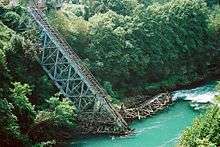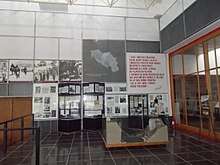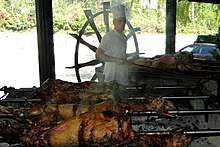Jablanica
Jablanica is a town in Herzegovina on the lake which bears its name, and along the Neretva River. It is known for the railway bridge over the Neretva that was destroyed by partisans during the Second World War, and for its necropolises in the Risovac settlement which are one of the three recognized ![]()
Understand
History
The Jablanica area has the scene of human activity since the bronze age, and flourished during the Roman era and Middle Ages, as evidenced by 42 sites with 683 necropolises with stećak tombs. The region acquired its wealth from caravans between Dubrovnik and Bosnia, crossing through the Vbras valley. The first census in 1477 recorded 3 villages in and around Jablanica (Žuglići, Ostrožac and Čehari), and the second census in 1488/89 reported a total of 67 homes with a mixed Christian and Muslim population. During the Ottoman period, the region of Jablanica received little attention, with Konjic receiving funding for hans and roads instead. Urbanization began in the Austro-Hungarian period with the construction of bridges, tunnels, houses and apartments, and a railway station.
Today, Jablanica is an oasis of rest and a popular vacation destination for locals, tourists, and travellers on the way from Konjic to Mostar. The town is powered by Neretvan hydroelectricity, and stone masonry remains an important economic activity.
Orientation
Jablanica and its surrounding villages are located in the Vbras valley.
Get in
The easiest way to get into Jablanica is either by bus from Konjic or Mostar, by train from the 🌍 Jablanica railway station , or by hitchhiking. Despite forming an at places narrow canyon, the Neretva Valley is mostly flat so it is also possible to reach Jablanica from Konjic or Mostar by bicycle. However, there are no provisions for cyclists, and the main road is too dangerous due to Bosnian traffic.
Get around
Jablanica is fairly small, and all locations of touristic value can be reached by foot.
See
Jablanica is best known for the railway bridge sabotaged by the partisan resistance during the Second World War in an effort to defend against the invading Nazi forces. The bridge and the nearby museum are the most important tourist attractions.

- 🌍 Railway Bridge (Srušeni most). 24/7. The original bridge was the scene of a battle during World War II between the Nazi occupation force and Yugoslav partisans under leadership of Joseph Tito. When the partisans found themselves surrounded in Jablanica, they staged an ingenious deception by blowing up the bridge themselves rather than defending it against an overwhelming Nazi invasion force with several armored divisions, a battle they could not win. German air reconnaissance reported that the bridge was sabotaged and concluded a diversion maneuver with an expected attack to the north instead, directing their main force away from the area. The slightly damaged bridge was subsequently repaired by partisan forces to cross the Neretva at Jablanica. Despite seeing through the partisan plan quickly, the Chetnik defenders were caught off guard and sustained heavy losses. By the time the German Luftwaffe provided air support, Tito's partisan forces had already crossed the Neretva. The repaired bridge was destroyed a second time by German bombardment. In 1969, Tito (then president of Yugoslavia) authorized a multi million dollar film production depicting the events at the Neretva railway bridge. Battle of Neretva by Bosnian director Veljko Bulajić spared no expenses, with a 10,000 men strong battalion of the Yugoslav Army participating and several actual Soviet tanks being destroyed for the film. The railway bridge was rebuilt for the film twice, and subsequently also destroyed twice, to get the perfect shot for the film. Because of the thick smoke caused by the explosions, the footage didn't make it into the final film -- the scene was instead shot on a replica of the bridge built in a movie studio in Prague. The remains of the bridge in the Neretva, along with a train used in the film, were left on site as a tourist attraction and can be visited. A path leads down to a viewing platform, which gives visitors a closer view on the bridge remains. Free.

- 🌍 Battle for the Wounded on Neretva River Museum (Muzej "Bitka za ranjenike na Neretvi"), Ulica Bitka za ranjenike bb, ☎ +387 61 175 317, fax: +387 36 752-705, e-mail: muzejjablanica@yahoo.com. Daily 09:00-16:00. Museum dedicated to the battle of Neretva for control of the nearby bridge over the river. Exhibitions tell the story of the battle with original documents, pictures, uniforms and weapons. A minor part is dedicated to the 1992-1995 civil war. A train used for the movie and artillery pieces are in front of the museum.

- 🌍
Dugopolje Necropolis (Nekropola Dugo polje). 24/7. Necropolis (from Latin necro meaning dead and polis meaning city, literally city of the dead) with 150 stećak tombstones of which 72 in the form of plates, 59 trunks, 14 tall chests, and 5 sarcophagi. Stećak tombstones can be found scattered across Bosnia and Herzegovina until the borders with Croatia, Serbia and Montenegro. There are an estimated 60,000 tombstones in Bosnia, the first of which appeared in the mid 12th century during the Middle Ages. The tombstones reached their peak in the 14th and 15th century, before gradually disappearing during the Ottoman occupation in the early 16th century. It is certain that the tombs were popular amongst Catholic and Orthodox Christians, but their original religious and ethnic origin remains unknown. Stećci were inscribed

Do
- 🌍 Ski Resort Blidinje - Risovac, Risovac (follow the R419 from Jablanica westward for 30 km until the road sign for the resort), ☎ +387 39 718-514. Dec-Mar 09:00-16:00. A small ski resort with 3 lifts and a total slope length of 3.5 km, targeting novice and intermediate skiers on an altitude between 1290 m and 1551 m. Day passes cost 20 KM for adults and 10 KM for kids.
Buy
- 🌍 Konzum, Jaroslava Černija, ☎ +387 36 750-700. 07:00-22:00. General purpose supermarket for food, drinks and convenience items.
Eat

- 🌍 Kovacevic, Magistralni put m17, ☎ +387 036 754 500, e-mail: info@restoran-kovacevic.ba. Upscale restaurant on the intercity road between Jablanica and Mostar, offering excellent grilled lamb and a view over the Neretva. Also serves breakfast, omelets, soup, etc. Pets are welcome.
- 🌍 Zdrava Voda, Mostarska (follow the highway to Mostar, few hundred meters past the museum), ☎ +387 36 753 151, fax: +387 36 757 087, e-mail: zdravavoda@bih.net.ba. On the highway south of Jablanica, with a 40-year tradition in grilled veal, roasted lamb, and grilled trout. Serves local alcoholic drinks (beer, wine). 11 KM - 30 KM.
Drink
- 🌍 Narona, Bitka za Ranjenike, ☎ +387 61 536 567. 07:00-23:00. A bar offering a view over the replica of the destroyed railway bridge. Clean restrooms available even without consumption. They do not sell disposable water bottles, so bring your own and ask them to refill them with tap water.
Sleep
- 🌍 Lendava, Lendava b.b., ☎ +387 36 751-500. Democratically priced hotel on the outskirts of Jablanica, on the east side of the Neretva.
Go next
- Konjic is on the Neretva River, 43 km southwest of Sarajevo, where in 2011 the Tito bunker and Bijenale contemporary art exhibition were opened to the public.
- Mostar